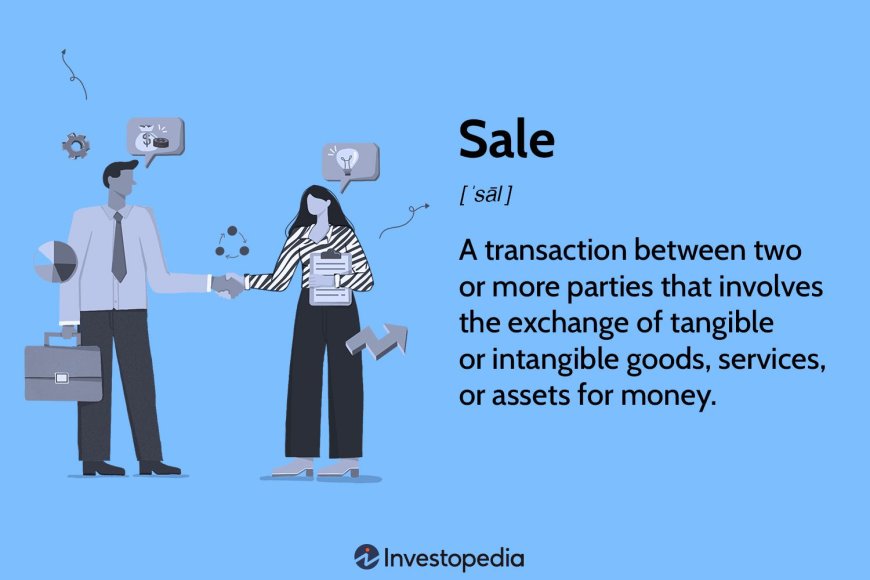An Introduction to Sales - For Kids & Adults

Sale refers to the process of exchanging goods or services for money or other forms of compensation. It is a transaction in which a seller offers products or services to potential buyers at a discounted price or under specific promotional terms to encourage purchase. The purpose of a sale is to generate revenue, clear inventory, attract new customers, increase market share, or achieve other business objectives.
Sales can occur through various channels, including physical retail stores, online platforms, direct sales, or business-to-business transactions. During a sale, prices may be reduced, discounts or promotions may be offered, or additional value-added incentives may be provided to entice customers to make a purchase.
Sales can be temporary, such as seasonal sales, clearance sales, or limited-time promotions, or they can be ongoing, such as regular discounts for loyalty program members. Sales can also involve negotiation and persuasion techniques to influence customer buying decisions.
The goal of a sale is to create a win-win situation, where both the seller and the buyer benefit. The seller aims to generate revenue, increase customer satisfaction, and build brand loyalty, while the buyer aims to acquire products or services of value at a favorable price or with added benefits.
Successful sales strategies often involve effective marketing and advertising campaigns, targeted promotions, personalized customer experiences, and excellent customer service. Sales teams or individuals may be responsible for managing customer relationships, identifying leads, negotiating terms, and closing deals.
Sales can encompass different types and approaches:
Retail Sales: Retail sales refer to the transactions that take place between a retailer and individual customers. These sales occur in physical stores, online platforms, or a combination of both. Retail sales often involve direct interactions with customers, where sales associates provide assistance, answer questions, and guide customers in their purchasing decisions.
Business-to-Business (B2B) Sales: B2B sales involve selling products or services from one business to another. These transactions typically occur between manufacturers, wholesalers, or service providers and their corporate customers. B2B sales often involve longer sales cycles, negotiations, and building strong relationships between the selling and buying organizations.
Direct Sales: Direct sales involve selling products or services directly to customers without the involvement of a physical retail store. This approach often includes methods like door-to-door selling, network marketing, or online direct selling. Direct sales rely on personal interactions, demonstrations, and building relationships to convince customers to make a purchase.
Here are five Indian or Disney cartoon examples that even kids can understand the concept of sale:
Motu Patlu: Motu Patlu is a popular Indian animated series that follows the adventures of two friends, Motu and Patlu. In several episodes, the characters engage in buying and selling activities, showcasing the concept of sale. Whether it's Motu trying to sell his samosas or Patlu running a store, kids can understand the basic idea of exchanging goods for money in these episodes.
Mickey Mouse: Mickey Mouse, the iconic Disney character, often finds himself in situations where he is involved in transactions and sales. Whether it's Mickey running a lemonade stand or selling balloons, kids can observe how Mickey engages in the exchange of goods for money, introducing them to the concept of sale in a simple and relatable way.
Chhota Bheem: In the animated series Chhota Bheem, the characters often participate in buying and selling activities within the village. Kids can see Chhota Bheem and his friends engaging in barter, selling goods, or purchasing items, giving them an understanding of how transactions occur and the concept of sale.
Doraemon: Doraemon, the popular Japanese anime series, features episodes where the characters engage in various activities related to buying and selling. Whether it's Nobita selling his old toys or the characters participating in a flea market, kids can grasp the idea of exchange and sale in these episodes.
The Jungle Book: The Jungle Book, a classic Disney film and animated series based on Rudyard Kipling's book, features episodes where Mowgli and his animal friends interact with human characters who engage in trading and selling activities. Kids can witness these interactions and learn about the exchange of goods for money or other items.
These cartoon examples provide kids with basic exposure to the concept of sale, showcasing characters engaging in buying, selling, and exchanging goods. While the focus of these shows may not solely revolve around sales, these moments within the story lines can help children develop an understanding of the concept in an engaging and relatable manner.
Here are three examples that layman adults can understand the concept of sale:
Big Bazaar: Big Bazaar is a well-known retail chain in India that offers a wide range of products, including groceries, clothing, electronics, and household items. Big Bazaar frequently organizes sales events such as "Sabse Saste Din" (Cheapest Day) or "Maha Bachat Sale" (Great Savings Sale), where customers can avail themselves of significant discounts, special offers, and bundled deals. Layman adults can understand the concept of sale through these events, as they involve discounted prices and promotional offers to attract customers.
Flipkart: Flipkart is one of India's largest e-commerce platforms, offering a vast range of products across various categories. Flipkart often organizes sale events like "Big Billion Days" or "Festive Dhamaka Sale," during which customers can find attractive discounts, flash sales, and exclusive deals. Layman adults can relate to the concept of sale through these online events, where they can purchase products at reduced prices and take advantage of limited-time offers.
End of Season Sales: Many clothing and fashion brands in India, both online and offline, organize end-of-season sales to clear out inventory from the previous season. These sales typically offer significant discounts on clothing, footwear, and accessories, making it an opportune time for layman adults to shop and save money. The concept of end-of-season sales is easily understood by adults as it involves purchasing products at reduced prices as new collections are about to be introduced.
These examples help layman adults understand the concept of sale as they involve discounted prices, special promotions, and limited-time offers. Sales events like those organized by Big Bazaar and Flipkart, as well as end-of-season sales, provide opportunities for adults to make purchases at lower prices and take advantage of cost-saving benefits.
In the Indian context, several sales formulae are commonly employed by brands to drive sales and engage customers. Here are some sales formulae in the Indian context:
Festive Offers: Festivals hold great significance in India, and brands leverage these occasions to offer special sales promotions. Whether it's Diwali, Eid, Navratri, or other regional festivals, brands provide attractive discounts, bundled deals, and festive-specific offers to entice customers during these celebratory periods.
Mega Sales Events: Brands often organize large-scale sales events with catchy names like "Big Billion Days," "Great Indian Sale," or "Super Value Week." These events, typically held on e-commerce platforms or in retail stores, offer significant discounts, flash sales, and exclusive deals to attract customers and drive sales during a specific time frame.
Buy-One-Get-One (BOGO) Offers: Buy-One-Get-One or BOGO offers are popular in the Indian market. Brands offer a second product for free or at a discounted price when customers purchase the first product at the regular price. This formula encourages customers to make immediate purchases, increasing sales volume.
Limited-Time Offers: Creating a sense of urgency through limited-time offers is a common sales formula in India. Brands provide time-limited discounts, early bird offers, or flash sales to motivate customers to make quick purchase decisions and take advantage of the deal before it expires.
Cashback and EMI Offers: Cashback and Equated Monthly Installment (EMI) offers are widely used to make high-value purchases more affordable. Brands partner with banks or financial institutions to provide cashback incentives or no-cost EMI options, allowing customers to spread out their payments over a period without incurring additional charges.
Loyalty Programs: Brands in India often establish loyalty programs to reward repeat customers. Through these programs, customers can earn points, discounts, or exclusive benefits based on their purchase history and loyalty to the brand. Loyalty programs foster customer retention, encourage repeat purchases, and increase sales.
Discounts for Bulk Purchases: Many brands offer discounts or special pricing for bulk purchases. This sales formula appeals to businesses, institutions, or individuals who buy products in large quantities. Bulk discounts incentivize customers to increase their order size and can lead to higher sales volumes.
Seasonal Clearance Sales: At the end of a season, brands often hold clearance sales to sell off excess inventory. These sales offer significant discounts to clear out remaining stock before new products are introduced. Layman adults can take advantage of these sales to purchase products at reduced prices.
These sales formulae in the Indian context cater to the cultural preferences, price sensitivity, and festive spirit of Indian consumers. By leveraging these formulae, brands aim to attract customers, increase sales, and establish a strong presence in the competitive Indian market.
In conclusion, sales play an important role in both children's understanding of transactions and layman adults' purchasing decisions. Through examples from Indian and Disney cartoons, kids can grasp the concept of sales as they observe characters engaging in buying, selling, and exchanging goods. These examples introduce them to basic sales interactions and the idea of transactions.
For layman adults, brands like Big Bazaar and Flipkart employ sales formulae such as discounts, special offers, and time-limited sales events to attract customers and drive sales in the Indian market. These formulae cater to the cultural preferences, price sensitivity, and festive spirit of Indian consumers. Car dealerships also utilize sales formulae by offering incentives, discounts, and special financing options during sales events.
The Indian context emphasizes the significance of festivals, limited-time offers, personalized deals, loyalty programs, and discounts for bulk purchases in sales strategies. Brands leverage these formulae to create a sense of urgency, engage customers, and provide value for their products and services.
Sales are an integral part of the consumer experience in India, where customers actively seek opportunities to make cost-effective purchases and take advantage of discounts and promotions. By employing effective sales formulae, brands can establish a strong presence in the Indian market, attract customers, and drive business growth.
What's Your Reaction?
 Like
0
Like
0
 Dislike
0
Dislike
0
 Love
0
Love
0
 Funny
0
Funny
0
 Angry
0
Angry
0
 Sad
0
Sad
0
 Wow
0
Wow
0








































































